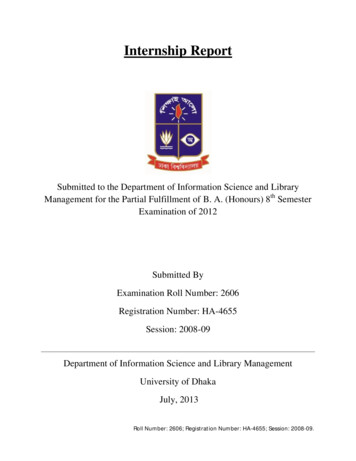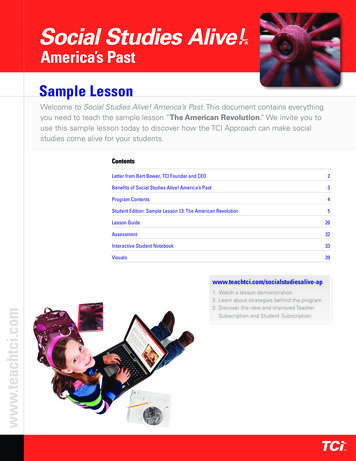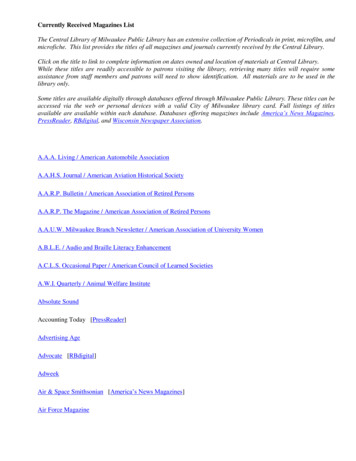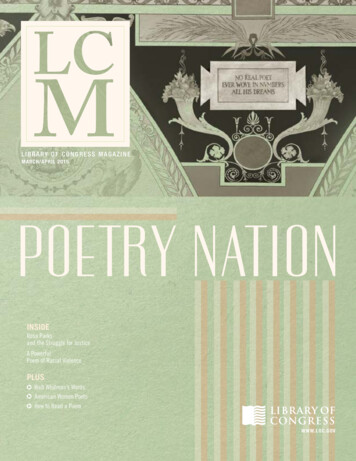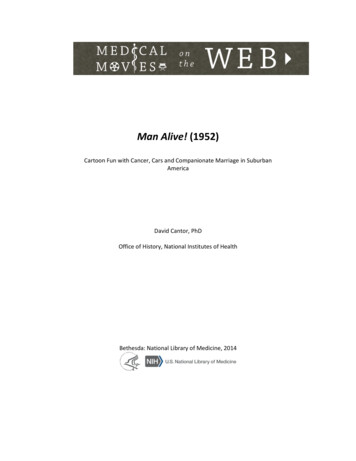
Transcription
Man Alive! (1952)Cartoon Fun with Cancer, Cars and Companionate Marriage in SuburbanAmericaDavid Cantor, PhDOffice of History, National Institutes of HealthBethesda: National Library of Medicine, 2014
Man Alive! (1952)ProducerPresented byStoryDesignMusicVoicesAnimationColorUnited Productions of AmericaAmerican Cancer Society (ACS)Bill Scott, William RobertsArt Heinemann, Sterling SturtevantBenjamin LeesVic Perrin, Dorothy Scott, Bill ScottCecil Surry, Phil Monroe, Rudy LarrivaRobert McIntosh, Boris Gorelick, Michi Kataoka, JulesEngelMedical AdvisorCharles S. Cameron (Medical and Scientific Director,ACS) 1Production manager Herbert KlynnExecutive producerStephen BosustowDirectorWilliam T. HurtzColorTechnicolor1 film reel (417 ft.), sound, color, 16 mm. answer print.NLM Unique ID:8800584AThe release of Man Alive! in 1952 signaled a change in American anti-cancercampaigns.2 Since their emergence in the early twentieth century, suchcampaigns had focused most attention on recruiting women into programs ofearly detection and treatment.3 But from the 1940s on, they supplemented thisapproach with one that targeted men. In the film component of the ACS anticancer campaign, this began with Enemy X released in 1942, followed by YouAre the Switchman (1946), The Traitor Within (1946) and You, Time and Cancer(1948).4 Man Alive! built upon this new appeal to men, but added much thatwas new.5At one level, this novelty might not be obvious. Much of Man Alive’s messagewas not dissimilar to that of other educational movies about cancer circulatingin the 1940s and early 1950s.6 Like those films it sought to persuade viewers togo to a regular physician at the earliest sign of what might be cancer. It warnedagainst delay in seeking competent help; against going to “quacks”; againstlistening to the unreliable advice of friends; and against turning to homeremedies. Finally, it taught viewers to recognize the “danger signals” of cancer,encouraged them to go for a regular health check-up from a recognizedphysician, and urged them to seek medical attention the moment cancer or itspossibility was identified. All these themes had been a regular part of cancereducation programs since the 1910s, whether aimed at men or women.1
Part of what was new about Man Alive! was where it was screened. It wasshown both in movie theaters as part of the regular theater schedule [Fig. 1],and in “non-theatrical” venues such as factories, clubs and other locations aspart of specialeducational events.As such, it blurred adistinction that hademerged in the1910s,wheneducationalfilmsbegantobedropped from theregular schedule offilm theaters, andshown in suchvenues only forspecial events. ManAlive! was one of aselect few cancereducationalfilmsthat made it backinto the motionpicture theatre (andthe drive-in) as partof the regular film Figure 1: Man Alive! was sometimes shown as part of the regularschedule, not as the theatre schedule. Source: ‘Illinois Theaters Book ACS Film as a Shortfeature, but as a Subject on Programs,” ACS Bulletin 1, 17 (May 5, 1952): 3.short subject thataccompanied the feature. 7 So great was the theater-demand that in 1953 theACS set up a rental service for 35 mm theatre prints. Television stations alsomade frequent use of the film.8 There were also plans for a Spanish-languageversion.9 It was the subject of a spread in Life Magazine, and was nominated foran Oscar (Best Documentary, Short Subjects) in 1952.10 One commentator laterdescribed it as an “educational film rivalling Woody Woodpecker in popularappeal.”11If the screening location of the film was novel, so too was its content and style.12This was the first cancer education film to try to get its message across by usinga purely comedic approach, producing “some hilarious results,”13 according tothe ACS. Earlier films had occasionally had humorous scenes, and cancer trailersand public service announcements (generally treated as distinct fromeducational shorts),14 had also striven for comedic effect.15 But Man Alive! wasthe first educational film to use comedy throughout, and set the stage for otherhumorous cancer education films in the 1950s, virtually all made by one studio –United Productions of America (UPA).162
United Productions of AmericaFounded in 1943, and incorporated in 1945, UPA had begun life makingsponsored films (industrials, political campaign movies, and educational andtraining films for the United States government), before expanding intotheatrical shorts and television in the late 1940s and 1950s.17 The company wasknown for its innovative approach to animation, often using minimal detail inthe layout and design of its films, and employing what came to be called limitedanimation.18 Such an approach was stylistic but it was also economic: the lessdetail and movement the less labor-intensive the artwork, fewer cels, the fasterthe production time, the lower the cost. Man Alive! was the second UPA filmdirected by Bill (William T.) Hurtz, who also directed many of UPA’s industrialfilms of the 1950s. UPA would produce two other humorous films for the ACS inthe 1950s – Sappy Homiens (1956) and Inside Magoo (1960), both of whichtargeted men.19Man Alive! was not one of the company’s more graphically-adventurous films,but it followed otherUPA films with its playfuluse of color, mutableforms,exaggeratedmovement, and sleightsof-hand to evoke moodor emotions.Itsbackground colors —sometimes bold andunmodulated,withabrupt transitions fromone color to another —could signal a character’semotional state. Forexample, the central Figure 2: Ed Parmalee shows “icy disdain” for his wife’ssuggestion that he seek help.male character turnsinto an angry devil, the screen suffused with red, or turns into an ice-cold“Eskimo”, the backdrop a block of blue.20 [Fig. 2] The mutable human form insuch scenes also serves to represent the moods and emotions the filmmakerssought to depict in the film: the male figure changes not only into a devil and anEskimo, but also an angry caveman, a sarcastic jester and a childish schoolboydunce to evoke emotions and attitudes.21 Likewise, he physically shrinks withfear, expands with (over)confidence, and leaps as high as the clouds in joy andrelief. Such transformations and exaggerations help create the movie’s antichumor, as do other visual tricks and sleights-of-hand that also serve to cut outcostly transitions. Thus instead of making a man dress himself, the filmmakershave his clothes fly off the bathroom valet-stand and apply themselves to hisbody (6 mins. 50 secs. to 6 mins. 56 secs.); instead of making him drive homefrom an automobile garage, UPA simply changed the background so that as hewalks the garage turns into to his bedroom. (4 mins. 38 secs. – 4 mins. 40 secs.)3
Such effects were more than entertainment: they were “entertainment with apurpose,”22 according to the San Francisco News. The colors, the shape-shiftinghuman form, and the antic humor, all sought to promote the ACS’s message ofearly detection and treatment for cancer, and to explain the psychologicalreasons why a man might delay seeking appropriate care. The message wasreinforced by elements of modernist design in the layout. For example,allusions to German expressionism played with perspective and rhythm tohighlight both the man’s fear of cancer and the danger posed by the disease.Thus, in the shrinking man sequence mentioned above, the man’s fear of canceris represented not only by his physically reduced state, but also by the stylizedbuildings and fence that tower over him, the slower pace his walk, and thefading of the jaunty music to the background (6 mins. 59 secs. to 7 mins. 09secs.). In another scene, the danger signals of cancer are written on a billboard,which together with an angular warning signal, dwarf and frame the man andhis wife, so indicating the threat posed by the possibility of disease. 23 [Fig. 3]Such visual cues were notunique to UPA. Mutable humanfigures were a common deviceinanimation;Germanexpressionism had influencedfilmmaking since the 1910s;limitedanimationwasoccasionally used by Hollywoodanimators; and theories ofperception grounded in minimalgraphic design pre-dated thecreation of the company. UPA’sinnovation was to bring theseingredients together in both Figure 3: The warning signs of cancer and the railwaymainstream theatrical animation warning signal.and sponsored film. Man Alive!’s director, Bill Hurtz was particularly enthusedby The Language of Vision (1944), György Képes’s treatise on the transformativepower of what he called visual language. Képes’ focus was on the role ofmodern art, design and advertising in visual education: He makes only a briefreference to film, and devotes not a word to animation. Nevertheless, he hadexperimented with animation in the 1930s, and, as Anna Vallye notes, his earlythinking on visual education was influenced by wartime public service initiatives,such as Disney films which, as he put it, were “designed to instruct soldiers inthe proper handling of their weapons, and to teach civilians how to combatdesease [sic], improve sanitation and to perform other functions contributing towar efforts.”24 He is often seen as a providing a rationale and justification forUPA’s playful use of geometry, line and color.25Influenced by wartime research on the role played by psychology in themanagement of human resources, Képes argued that modern art was not onlydifferent from but also superior to classical painting. Preoccupied with linearperspective and object-centered representation, classical art was based on an4
erroneous belief in the fixity of experience, which failed to account for thedynamic ever-changing condition of modern life, and so created a disconnectbetween viewers and their experience of the world. In Képes view, classicalapproaches to painting should be and were being replaced by new approachesto art that reclaimed surface treatment, highlighted the difference between apainting and its object (obscured by classical art), and focused on the dynamicqualities of color, plane, line, tone, and rhythm – a modern art that, he believed,could reinterpret the world for a people facing a dynamic constantly changingworld by feeding into human desires for balance and unity. Thus, designers andadvertisers, he claimed, had much to learn from modern artists. Képes arguedthat the latter had in effect created a new visual language that was universaland international: it knew “no limits of tongue, vocabulary, or grammar,”26 andcould be could be read and understood, at a glance, by almost anyone, “theilliterate as well as by the literate.”27 It was capable, he claimed, ofdisseminating knowledge more effectively than almost any other vehicle ofcommunication, and so offered a powerful set of intellectual techniques or toolsfor training, education and social action.Although Hurtz’s enthusiasm for The Language of Vision is well known, quitehow Képes influenced him is less clear. Michael Barrier argues that Képesvalidated the sorts of sponsored films that Hurtz and UPA were making byportraying advertising as "art" able to disseminate socially useful messages, and“train the eye, and thus the mind, with the necessary discipline of seeingbeyond the surface of visible things, to recognize and enjoy values necessary foran integrated life." 28 The problem with this argument is that although UPAfilmmakers needed sponsorship to survive, some of their sponsors promotedvalues with which the filmmakers disagreed – the “fascist-minded”representatives of the American Petroleum Institute who sponsored Man on theLand (1951) are often mentioned.29 If Képes did provide a validation of thesefilms, it was not so much their explicit messages, for example about thepetroleum industry or free enterprise. It was more fundamentally about what itmeant to live in a world that was constantly changing – technologically,politically, socially and culturally – and how people might adapt to such change.Such transformations and innovations were a constant theme in UPA films. Insome, such as Man on the Land, they were primarily technological (petroleumand the social and technological transformations it facilitated), in others theywere also cultural, such as in Brotherhood of Man (1946) which argued forcultural plurality and tolerance in a post-war world that seemed to be shrinking(through improved transportation?) and bringing previously separate culturesrapidly together. Others focused on the technological and social innovationsand transformations of post-war life – including suburbanization, automobiles,highways, advertising hoardings, companionate marriage, and the baby boom.The sparse graphic design of these films, the mutations of form, the plays withcolor and perspective, all aimed to represent these ever-changing facets ofcontemporary life and the problems of adapting to them, and they did so in adistinctive modern way, akin to the Kepesian dynamic language of forms – for5
example, constantly highlighting the distinction between the film and itssubject, blurring the boundary between figures and their background.For UPA’s filmmakers, animation was an ideal tool for representing suchtransformations and the process of adapting to them, and provided new ways ofrepresenting that were quite different to those of live-action films. Thus, in a1946 article that drew on the company’s experience of making films for themilitary, two of UPA’s founders – John Hubley and Zachary Schwartz – called fora new approach to visual education based on the unique possibilities ofanimation. 30 In their view, animation offered something that photographynever could. The drawings on which it was based could function as symbols fora general concept, unlike the photograph which could only record a singlespecific thing, from a single fixed perspective. Photographs, they claimed,created understanding only implicitly, through the vicarious experience of aspecific situation. By contrast, animation represented the general idea directly,allowing the audience to experience an understanding of the entire situation.Hubley and Schwartz’s examples were war-time training movies, but theiraccount also suggests how animation was uniquely placed to explain thecomplex technological and social changes of the post-war world, the problemspeople faced in coming to terms with them, and the ways in which they mightadapt.Psychological knowledge played a key role such adaptive processes. Thus, onthe one hand, Hubley and Schwartz turned to psychological tests and reactionstudies conducted by the military to argue for the exceptional popularity of andeffectiveness of animated technical and orientation films such as the Snafuseries produced by UPA.31 On the other hand, UPA routinely used animation topresent the science of psychology as a key to adaptive responses that the filmssought to promote in their audiences. Thus, A Few Quick Facts About Fear(1945) explained the physiology of fear to servicemen, and, in the context ofworld war, presented it as a normal adaptive response to danger; Flat Hatting(1946) graphically represented the childish impulses that prompted Navy pilotsto buzz the ground (so flattening hats) in an effort to wean them from thepractice; Swab your Choppers (1948) explained the psychological roots of poordental hygiene (portrayed as between a lazy and an ignorant self) thatcompounded the problems of eating in soft “civilized” foods; Look whoseDriving (1954) highlighted the psychological impulses behind bad driving; and,as I shall show below, Man Alive! highlighted the psychological problems behindthe problem of delay, and turned to the science of psychology to encouragemen to overcome this and other maladaptive behaviors.Films for MenUPA’s approach to moviemaking thus helped to transform cancer educationfilms by introducing a new visual language, new concerns about the changes ofthe post-war world, the problems people had in adapting to such changes, andthe role of psychology in helping them to adapt. Crucially, they helpeddistinguish cancer movies targeted at men from those targeted at women. Until6
1952 most cancer education films – whether aimed at men or women – werelive-action motion pictures in black-and-white, dramatic recreations of the pathsby which patients got to the doctor, and morality plays about the need to seekearly detection and treatment from a recognized physician. This began tochange with The Traitor Within and later Man Alive!. While these films alsotraced patient pathways to the physician, and told moral tales about people’sresponses to cancer or its prospect, both were in Technicolor rather than blackand-white, and both were modernist animated cartoons rather than live-action.But The Traitor Within and Man Alive! were different in one key respect. Whilethe former has occasional comedic moments, Man Alive! is a comedy, full ofplayful humor throughout the film.32Thus by the early 1950s films aimed at men began to include both modernistcartoon animation and comedy. By contrast, movies aimed primarily at womendid not use cartoon animation, nor did they use visual humor of the sort thatUPA excelled at.33 Women’s films in the 1950s were live-action (mostly blackand-white) melodramas and how-to movies, such as Breast Self-Examination(1950), which taught viewers that technique.34 Furthermore, while manywomen’s films highlighted anxieties about the potential cost to the family of awife and mother with cancer, none of the films targeted at women in the 1950sdeployed material, consumer and leisure pursuits as creatively as Man Alive!35In Man Alive! marital relations and the symbols of affluent suburban life becameways of explaining the ACS’s recommendations regarding cancer. They alsobecame ways of explaining how men might adapt to this way of life.It should first be noted that before Man Alive! few cancer education films aimedat men had focused on such issues. For example, Enemy X (1942) is not locatedin the suburbs, but in a city threatened by a murderous killer: a gangster orperhaps a fifth columnist (the film was released the year after the Japaneseattack on Pearl Harbor). By contrast, the enemy in The Traitor Within (1946) is afactory worker gone bad: a transformed cell that kills its coworker cells anddisrupts the production line (within the factory-like organ). Such a portrayalharkened back to wartime scares about fifth columnists; touched on post-warconcerns about the “threat” posed by labor unions in an age of fullemployment; and suggested emergent Cold War anxieties about communistdisruption of American industry. Man Alive! shifts the focus from industry to thehome, from city to suburb, from production to consumption, and from work toleisure.There were good reasons for a cancer campaign to focus on suburban life andleisure. Despite growing post-war optimism that many cancers could be cured ifcaught early, this group of diseases remained one of the most feared. In part,the concern focused on the disease itself (which threatened pain, disfigurementand death) and its treatments, mainly surgery and radiotherapy (which alsothreatened pain, disfigurement and death). But public concern about cancerwent far beyond the disease and the therapeutic interventions against it. Formany people, cancer also raised the specter of financial hardship, and thestigma of dependency and pauperism. A huge demographic shift was taking7
place from city to the suburbs, fed by the construction of highways, a boomingeconomy, and G.I. mortgages that subsidized white flight out of the big cities toouter suburbs (and migration to suburban California). Cancer endangered thedream of a middle-class, suburban life, with a house, family, car, and the leisureto enjoy them.The high cost of cancer care was a particular concern here. Cancer wasenormously expensive to treat, especially in the terminal stage of the disease,and imposed a sometimes-overwhelming strain on family budgets and cohesion.Alone in suburbia, far from the help of other relatives, post-war families oftenhad few resources that they turn to alleviate the strain of caring for someonesick with cancer.36 Much of the burden of care fell on the spouse of the personwith cancer, and the fear was that their financial and emotional resourceswould quickly be depleted, forcing them to turn to church, charity and welfarefor help. Cancer thus disrupted hopes of financial and social independence uponwhich the post-war nuclear family depended for survival. As seriously, it alsothreatened to disrupt the division of labor within the 1950s family, forcing meninto roles that were gendered female, and women into roles that weregendered male.37 It also raised the prospect of such families producingmaladjusted children, so feeding into concerns about the role of the family inproducing juvenile delinquency and childhood psychic ills.38Much of the concern about family breakdown focused on the impact of canceron the employment prospects of men, the breadwinner in 1950s domesticideology. Thus in 1954, the federally-supported National Cancer Institute notedthat many cancer patients found it difficult to take advantage of newopportunities for creative or productive employment, since most industriesrefused to employ individuals who had had cancer because of the increased riskof compensable illness.39 And while such problems affected both men andwomen, the NCI argued that men were particular hard hit. It also affected allthose who normally relied on him. A man’s wife and his children would also beharmed as cancer ate into family budgets through the combination of the highcost of care and the loss of male income. It was here that the other dangers tothe dream of post war independence and affluence threatened. The NCI notedthat there was the loss of status or self-respect when a family was forced toaccept relief which they had never previously needed. There were also the longterm effects on children whose mother assumed a wage-earning role because ofthe father’s illness, and the difficulties faced by a father who had to assume therole of caring for the children when a mother was ill.One of the first films to deal with such issues was You Are the Switchman (1946).The film comprises two morality plays about John Dole, who is, as the narratorputs it, “just an average American”, with a good job, a comfortable home, andalmost enough money saved to build the house he and his wife Mary havedreamed of. In the first of the two stories, John dies because he delaysconsulting a physician: his wife is left a widow, forced to seek paid employmentand to care for their children alone, their dreams of a future family life togetherdestroyed.40 In the other story, John survives because he does not delay. This8
second story ends with the “Dole family team still intact,” and with a promotioncoming up at work, John is making plans for the dream home he hopes to buildfor Mary and the kids. Mary too is able to plan for the future, and their children,Bob and Jane (seen playing with toys in front of the family radiograph) are, asthe narrator puts it, “snug and secure” in the family home.Man Alive! built on such concerns about the impact of cancer on married life,albeit without the children. The movie tells the story of Ed Parmalee whoignores the warningsigns of what might becancer as he ignoresthe warning signs thathis car engine needsWhenattention.41Ed’s car eventuallybreaks down he goesto a dodgy carmechanic,Clyde,hoping to save money,but Clyde ruins theengine, costing himmore than if he hadgone to a reputablecar mechanic in theFigure 4: After much hesitation and procrastination, Ed Parmaleefirst place. Ed’s failuregets a thorough check-up from a reputable doctor.to respond to theearly warning signs of car-trouble is mirrored by his response to persistentindigestion, one of the warning signs of cancer. The movie shows how Ed avoidsseeking qualified medical attention much as he had previously avoided seekingqualified mechanical help for his car: he is afraid of what the doctor might find.The movie also shows the consequences of delay, but not the sameconsequences as in You Are the Switchman. Where the earlier film highlightedthe mortal consequences of delay, Man Alive! highlights its emotional andpsychological consequences. In particular, it shows how the psychology of delaycan destroy the tranquility of married life and the pleasures of automotive andsporting activities.But Man Alive! also uses married life and leisure in another way. It uses them aspedagogical tools to explain the ACS’s approach to cancer. Take for exampleEd’s car. In this film the car provides an opportunity to show how Ed’s anxietiesabout the engine exacerbate the pain of ownership and dampen its pleasures.But it is also an opportunity to explain about the early warning signs of cancerand what to do about them: just as a car engine gives early warning signs of aproblem, the narrator tells Ed, so too does the body. Thus, when Ed’s stomachplays up, the narrator reminds him that he had earlier ignored the warning signsthat his car engine needed attention just as he is now ignoring the warning signsof what might be cancer. Clyde’s quick fix had junked Ed’s engine. The risk isthat he may suffer the same fate as his car.9
As historian Leslie Reagan has noted, such mechanical analogies were not foundin movies targeted at women.42 Despite rising numbers of female drivers,automobiles and their engines were generally seen as masculine domains,opportunities for men to assert individuality and freedom. Historians haveportrayed such assertions as against the conformity of post-war managerialculture, and the encroachment of a feminized suburban American culture, thatdevalued vigorous masculine traits, and validated matriarchal values.43 Hencethe jokes about women drivers: While women might have needed anautomobile to run the suburban household, they were represented as timid,unskilled drivers, unknowledgeable about what happened under the hood, therepeated butt of male humor. Man Alive! reversed the humor, presenting Ed asa willful protagonist who ignores the warning signs of his car (and body) goingwrong and the good commonsense of his wife Marion that he go to a reputablemechanic (and doctor).If Man Alive! reversed the humor about women drivers to encourage men toseek appropriate cancercare, it also used fears ofthe city to highlight malepretensions to knowledgeand the dangers ofquackery,patentmedicines,andfolkwisdom. At a time whenaffluent white Americanswere fleeing to thesuburbs,ManAlive!reminded them of theperceived disorder anddangers of the city theyhad left behind. The film Figure 5: The Dangers of Quackery and the Citylocated the problems ofdodgy car mechanics and quacks in the city, in seedy, lower-class, perhaps‘ethnic’, neighborhoods.44 By contrast, Glassner’s, the name of the business ofthe reputable mechanics, is located in a clean, efficient, modern garage, and thereputable physician works in a suburban location, with a manicured hedge orlawn, Life Magazine in the waiting room, and an efficient female receptionist. Itis to this world that Marion constantly directs Ed, but Ed does not take his wife’sadvice, at least at the beginningFor Ed the city is both a site of temptation and peril. It attracts him with thepromise of an easy and cheap fix, but it is also where his claims to knowledgeare exposed as sham. He is a stranger in a strange land, an innocent in a worldof predators, where his ignorance of cars, bodies and the city is exploited by theunscrupulous and compounded by the ill-informed. Thus his car engine is ruinedbehind closed doors, in a shady backstreet garage (a contrast to Glassner’sopen, modern, and efficient garage); his fears of cancer are almost exploited by10
a quack, J. Kirkham Headstone, the self-styled Edison of Medicine [Fig. 5], whoseseedy urban doorway is peppered with a mess of self-advertising andextravagant claims of cures (a contrast to the physician’s understated suburbanoffice with a single shingle listing his name); and he is misled by automotiveadvice he gets from the ignorant public, the same figures who offer himworthless advice on cancer as he plays a game of golf. Apparently the smell ofurban decay and bad advice can follow a man, even to the fairway and green.45To add to his problems, Ed’s ignorance is exacerbated by fear. Fear helps propelhim into the hands of the dodgy car mechanic (and almost to the quack), andopens his ears to misinformed advice and his wallet to the enticements of quickfix patent medicines. It also leads him to ignore the advice of his wife. It is shewho, like the wife in You Are the Switchman, encourages Ed to see his physician.Yet, Ed refuses to listen to her, and eventually explodes in anger beforerepenting and agreeing to go. Thus, one of the messages of the film for men isthat a wife can bring wise counsel, but it should also be noted that – unlike inYou Are the Switchman – it is not the wife who persuades Ed of this fact. Ed’sconversion comes only after a conversation between him and the film’s malenarrator. It is this narrator who persuades Ed that his anger toward Marion isunreasonable, and that he should do as she says and go to the doctor. Ed’s wifemay be a source of sound advice, but it takes a man-to-man talk to persuade Edto listen to her.If a wife’s wise counsel alone cannot persuade a man to change, what can? Theanswer the film suggests is the science of psychology, and the self-awareness itbrings. As I’ve noted above, the theme was not new to UPA films, but it was newto cancer movies.46 Man Alive! is unique among cancer movies of the 1950s inthe attention it gives to the psychology of delay (and of not listening to wives).The narrator divides Ed’s responses to Marion’s suggestions into fourcategories—denial, sarcasm, icy disdain, and unreasoning anger (where hechanges respectively into a schoolboy, jester, Eskimo and caveman) —whi
Man Alive! was the first educational film to use comedy throughout, and set the stage for other humorous cancer education films in the 1950s, virtually all made by one studio - United Productions of America (UPA). 16. Figure 1: Man Alive! was sometimes shown as part of the regular theatre schedule. Source: Illinois Theaters Book ACS Film as a .

